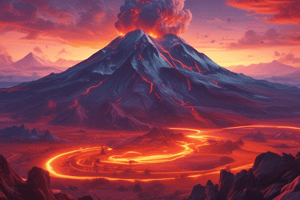Podcast
Questions and Answers
What is the main reason for the formation of mountains?
What is the main reason for the formation of mountains?
- volcanic eruptions
- plate tectonics (correct)
- glaciers
- weathering and erosion
Which type of mountain is formed when two plates collide and the Earth's crust is folded?
Which type of mountain is formed when two plates collide and the Earth's crust is folded?
- Stratovolcanoes
- Volcanic mountains
- Fold mountains (correct)
- Block mountains
What is a characteristic of mountains?
What is a characteristic of mountains?
- high elevation (correct)
- gentle slopes
- uniform ecosystems
- low elevation
What is the process by which volcanoes are formed?
What is the process by which volcanoes are formed?
What is a characteristic of volcanoes?
What is a characteristic of volcanoes?
Which type of volcano is gently sloping with a broad base?
Which type of volcano is gently sloping with a broad base?
What is an example of a mountain range?
What is an example of a mountain range?
Flashcards are hidden until you start studying
Study Notes
Mountains
- Formation: Mountains are formed through the process of plate tectonics, where the Earth's lithosphere is pushed upwards by the movement of tectonic plates.
- Types:
- Fold mountains: formed when two plates collide and the Earth's crust is folded.
- Block mountains: formed when a plate is pushed upwards by the movement of a fault.
- Volcanic mountains: formed by the accumulation of lava and volcanic debris.
- Characteristics:
- High elevation
- Steep slopes
- Snow-capped peaks
- Glaciers
- Diverse ecosystems
- Examples:
- The Himalayas
- The Rocky Mountains
- The Andes
Volcanoes
- Formation: Volcanoes are formed when magma from the Earth's interior rises to the surface, resulting in eruptions of molten rock, ash, and gas.
- Types:
- Shield volcanoes: gently sloping volcanoes with a broad base.
- Stratovolcanoes: tall, conical volcanoes with a steep slope.
- Cinder cones: small, steep-sided volcanoes formed from accumulated ash and cinder.
- Characteristics:
- Vent or crater at the summit
- Eruptions of lava, ash, and gas
- Volcanic rocks and minerals
- Landforms such as calderas and lava flows
- Examples:
- Mount St. Helens
- Mount Fuji
- Mauna Loa
Studying That Suits You
Use AI to generate personalized quizzes and flashcards to suit your learning preferences.




